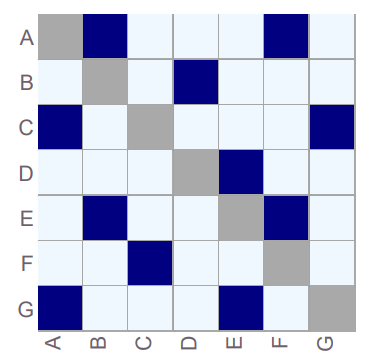久々にDesign Structure Matrixの記事になります。 今までDesign Structure Matrixの描画にはGadfly.jlパッケージのヒートマップ機能を使用していました。
例としては以下のようなものになります。

ただこの描画方法ですとDSMの要素の有無を色でしか表現できず複雑なDSMを描画するには不得手でした。また、DSMの派生形であるMDM(マルチドメインマトリックス)の描画も難しい状況でした。
こういった状況でしたので他の描画方法を探しておりましたが、Plotly.jlのtablesが良さそうでしたので挑戦してみます。
Plotly.jl
Plotly.jlもGadfly.jl同様、Juliaの代表的な描画ライブラリです。
このパッケージのdocumentのexampleにTablesという表を描画する例がありましたのでこれを応用してみます。
下のように綺麗な表を描画できるようです。他のパッケージにはなかなかこういったものは見当たりませんでした。

DSMはどちらかといえばグラフというよりも表ですのでこのように表として出力できれば複雑な構造のDSMでも描画できそうです。
DSMの描画
結果として以下の入力から
DSM = [0 1 0 0 0 1 0; 0 0 0 1 0 0 0; 1 0 0 0 0 0 1; 0 0 0 0 1 0 0; 0 1 0 0 0 1 0; 0 0 1 0 0 0 0; 1 0 0 0 1 0 0]; label = ["Element 1","Element 2","Element 3", "Element 4","Element 5","Element 6","Element 7"];
以下の出力が得られるようになりました。

念の為Gadflyの時のものを再掲しますが、Plotlyの場合元が表ですのでテキストを埋め込みやすく、結果として複雑な表を作ることができました。

ただしPlotlyにも以下のような弱点があります。
- セルを正方形にするのは手動調整になる。
- セルサイズ手動調整の融通が効かない
- スクロールが必要な程度に表が大きくなった場合、描画のバグが生じることが多い
- 静止画を出力するためには別のパッケージが必要
などとなかなか厄介な欠点を抱えておりますが、Gadflyの時よりかはまだマシかもしれません。
他にも良いパッケージをご存知の方がいらっしゃいましたらご紹介いただければ幸いです。
最後にソースコードを掲載して、今回はここまでにします。
using Plotly DSM = [0 1 0 0 0 1 0; 0 0 0 1 0 0 0; 1 0 0 0 0 0 1; 0 0 0 0 1 0 0; 0 1 0 0 0 1 0; 0 0 1 0 0 0 0; 1 0 0 0 1 0 0]; label = ["Element 1","Element 2","Element 3","Element 4","Element 5","Element 6","Element 7"]; function DSM2table(DSM,label) (DSMsize,) = size(DSM); element_number = [i for i in 1 : DSMsize] tabledata = [label element_number editDSM(DSM)]; headerdata = ["Label" "No" string.((element_number'))]; return tabledata, headerdata end function editDSM(DSM) (r,c) = size(DSM); DSM = string.(DSM) for i in 1 : r for j in 1 : c if i == j DSM[i,j] = string(i) elseif DSM[i,j] == "0" DSM[i,j] = "" else DSM[i,j] ="●" end end end return DSM end function colorDSM(DSM) (r,c) = size(DSM); fillcolor = string.(DSM); for i in 1 : r for j in 1 : c if i == j fillcolor[i,j] = "grey" else fillcolor[i,j] ="white" end end end return fillcolor end function colorlabels(DSM) (r,c) = size(DSM); colorlabel = string.(ones(r,2)); for i in 1 : r for j in 1 : 2 colorlabel[i,j] = "grey" end end return colorlabel end function fontcolor(cellsfillcolor) fontcolor = copy(cellsfillcolor) (r,c) = size(cellsfillcolor); for i in 1 : r for j in 1 : c if cellsfillcolor[i,j] == "grey" fontcolor[i,j] = "white" else fontcolor[i,j] ="black" end end end return fontcolor end function fontsize(values) (r,c) = size(values); fontsize = ones(r,c) for i in 1 : r for j in 1 : c if values[i,j] == "●" fontsize[i,j] = 20 else fontsize[i,j] =20 end end end return fontsize end function table1() (values,headerdata) = DSM2table(DSM,label) cellsfillcolor =[colorlabels(DSM) colorDSM(DSM)]; trace = table( columnwidth=[5, 1], header=attr( values=headerdata, align="center", line=attr(width=1, color="black"), height = 30, fill_color="grey", font=attr(family="Arial", size=20, color="white") ), cells=attr( values=values, align="center", line=attr(color="black", width=1), fill_color = cellsfillcolor, font_color= ["white","white","black"], font_size = 20, height = 30, font=attr(family="Arial") ) ) p = plot(trace) end